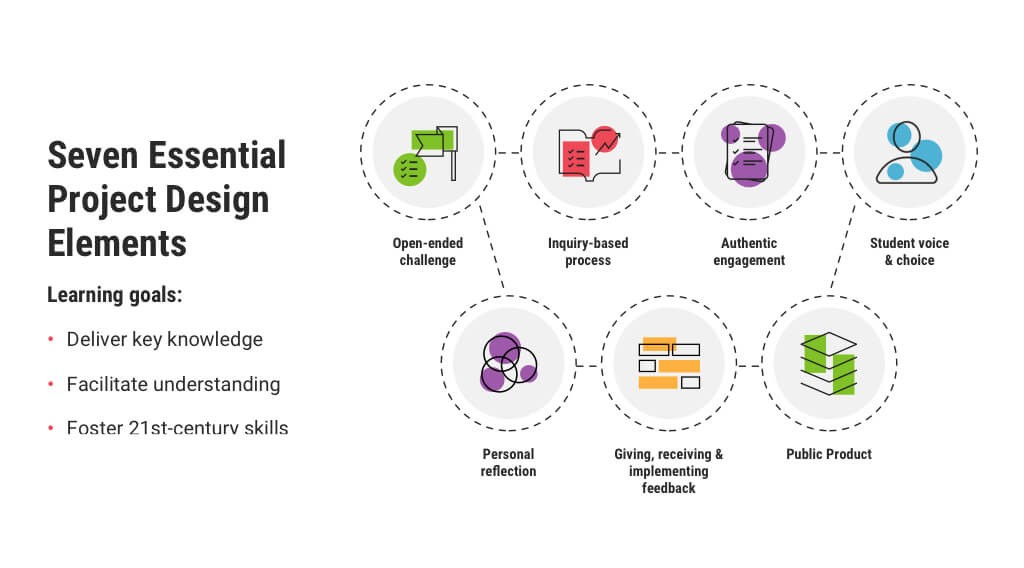Project-based learning (PBL) has a long history, dating back to the late 19th century. This hands-on approach to education allows students to acquire knowledge and skills by tackling real-world challenges. But How Do Projects Help Students Learn, and what does the research say about their effectiveness? Let’s delve into the evidence and explore the significant benefits of PBL.
What is Project-Based Learning (PBL)?
PBL is an instructional method where students learn by actively engaging in projects that mirror real-world problems. Often called “learning by doing,” “experiential learning,” or “discovery learning,” PBL immerses students in hands-on experiences. From pre-K to 12th grade, PBL takes various forms, including debates, field trips, mock trials, and community service projects. The possibilities are vast and adaptable to different subjects and age groups.
 Seven essential project design elements
Seven essential project design elements
The Research Behind PBL: Does it Work?
PBL aligns with the project-based nature of everyday tasks and future careers. Instead of rote memorization, students dissect problems, collaborate, and develop solutions. While still young, learners cultivate crucial skills like self-sufficiency, creativity, and critical thinking—all vital for success in the professional world.
Research indicates PBL effectively promotes learning across various subjects, including social studies, science, math, and literacy. Studies by the Buck Institute for Education suggest PBL benefits all students, particularly those facing educational disparities. Furthermore, research from Lucas Education Research in 2021 demonstrated PBL’s positive impact on learning equity, especially following the educational disruptions caused by the COVID-19 pandemic. Key findings included:
- Improved performance on AP exams for high school students in PBL classrooms, regardless of socioeconomic background.
- Enhanced performance on multi-subject assessments for middle school students in high-poverty areas participating in PBL science programs.
- Significant learning gains in social studies and informational reading for second-grade students in low-performing schools utilizing PBL.
While more research is needed, existing evidence strongly supports PBL as a powerful tool for improving educational equity and individual student outcomes.
Key Elements of Effective Project-Based Learning
According to the Buck Institute, effective PBL incorporates seven crucial elements:
- A Central Question or Challenge: Projects revolve around a significant, open-ended question, problem, or challenge.
- Inquiry-Based Process: Learning is driven by curiosity and student-generated questions.
- Integration of Prior Knowledge: Projects build upon existing concepts and skills.
- 21st-Century Skills Development: Students hone critical thinking, communication, collaboration, and creativity.
- Student Choice: Learners have a voice in shaping their projects.
- Feedback and Revision: Opportunities for iterative improvement are provided.
- Presentation of Findings: Students share their process, methods, and results.
The Many Benefits of Project-Based Learning
PBL offers a wide array of benefits, contributing to improved academic performance, skill development, and student engagement. These benefits include:
- Building 21st-Century Skills: PBL fosters essential skills like teamwork, problem-solving, research, and technology utilization.
- Enhancing Critical Thinking: Students develop analytical skills to tackle complex challenges.
- Connecting Learning to the Real World: PBL bridges the gap between theory and practice.
- Improving Student Attitudes Towards Education: Hands-on projects increase engagement and enthusiasm for learning.
- Boosting Motivation: Meaningful projects inspire students to explore and learn.
- Reinforcing Social and Emotional Learning: PBL promotes collaboration, communication, empathy, and self-awareness.
- Sparking Creativity and Curiosity: Students are encouraged to think creatively and pursue their interests.
- Supporting In-Depth Understanding: PBL promotes deeper comprehension and knowledge retention.
- Empowering Students: Students gain autonomy, confidence, and a sense of purpose.
- Encouraging Perseverance: PBL fosters resilience and a growth mindset.
- Allowing for Differentiation: PBL accommodates diverse learning styles and abilities.
- Promoting Lifelong Learning: PBL cultivates a passion for learning beyond the classroom.
Conclusion: The Power of Learning by Doing
Project-based learning offers a compelling approach to education that empowers students to actively construct their knowledge and develop essential skills. By engaging in real-world projects, students gain a deeper understanding of concepts, cultivate crucial 21st-century skills, and develop a lifelong love of learning. The evidence clearly demonstrates the positive impact of PBL on student achievement and overall educational experience.